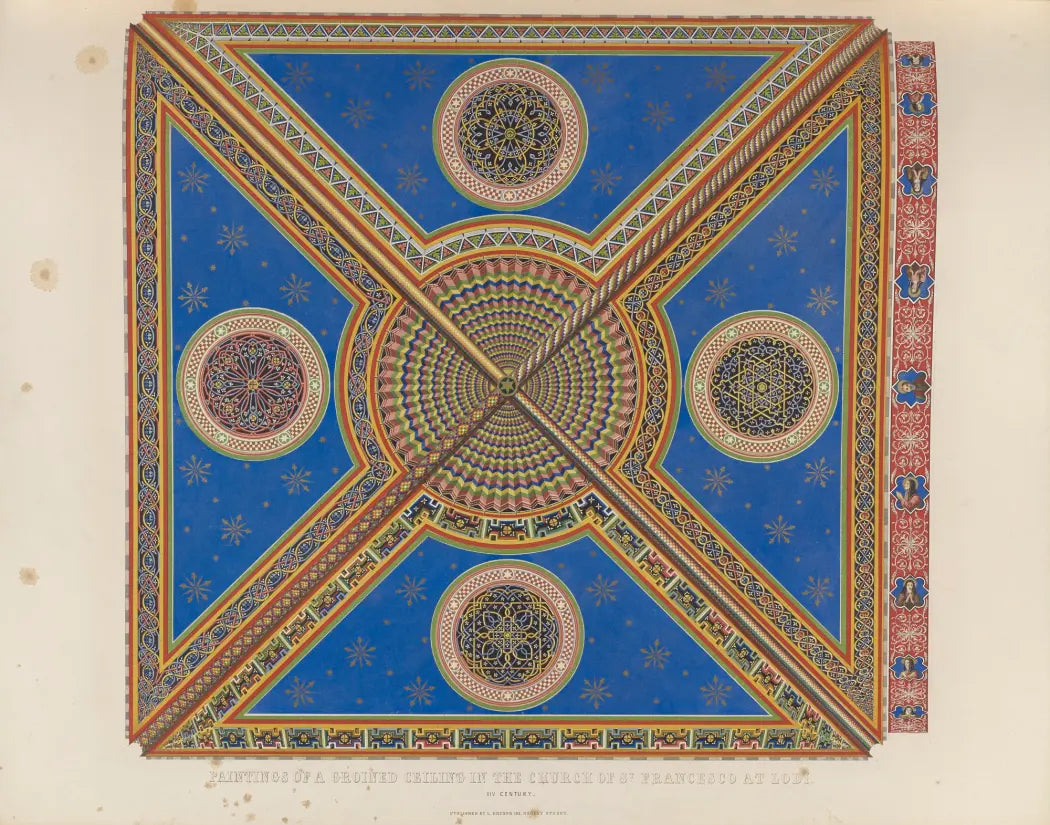ANTONIO RAIMO GALLERY
Gruner, Ludwig, Specimens of Ornamental Art, Painted Domes
Gruner, Ludwig, Specimens of Ornamental Art, Painted Domes
Couldn't load pickup availability
Ludwig Gruner (1801–1882) was a prominent 19th-century art historian and illustrator known for his detailed works on art and architecture. His book "Specimens of Ornamental Art" is particularly notable for its illustrations of various artistic and architectural elements from different periods and styles. Here’s an overview of Gruner’s work on painted domes:
### **Ludwig Gruner and "Specimens of Ornamental Art":**
- **Background:** Ludwig Gruner was a German art historian, engraver, and painter. He is best known for his detailed studies of decorative art and architecture. His work often focused on historical and classical styles, documenting and preserving the intricacies of various artistic elements.
- **"Specimens of Ornamental Art":** This work is a comprehensive collection that features illustrations and descriptions of ornamental art from various historical periods. It showcases a range of artistic styles and elements, including frescoes, mosaics, and architectural decorations.
### **Painted Domes in Gruner’s Work:**
- **Description:** In "Specimens of Ornamental Art," painted domes are depicted with high detail. These illustrations typically include decorative and artistic elements found in the domes of churches, palaces, and other significant buildings. Painted domes often feature elaborate frescoes, geometric patterns, and mythological or religious scenes.
- **Historical Context:** The painted domes illustrated by Gruner reflect various artistic traditions, including Renaissance, Baroque, and Rococo styles. These domes often served as focal points in architectural design, combining artistic and structural elements to create visually striking interiors.
- **Artistic Significance:** The depiction of painted domes in Gruner’s work highlights the importance of these architectural features in historical art. Domes were often adorned with intricate frescoes and decorations that contributed to the grandeur and aesthetic impact of the buildings.
### **Legacy and Impact:**
- **Preservation of Art:** Gruner’s illustrations are valuable for their detailed representation of historical art and architecture. They serve as a record of ornamental styles and techniques that might otherwise have been lost or forgotten.
- **Influence on Art History:** Gruner’s work has been influential in the study of decorative art and architectural history. His detailed illustrations provide insights into the artistic practices of different periods and contribute to a broader understanding of historical art forms.
- **Continued Relevance:** Today, Gruner’s work remains a reference for scholars and enthusiasts of art and architecture. The detailed images of painted domes and other ornamental art provide a window into the artistic achievements of past centuries.
In summary, Ludwig Gruner’s "Specimens of Ornamental Art" is a significant contribution to art history, particularly in its detailed depiction of painted domes and other ornamental elements. His work helps preserve and document the rich artistic heritage of various historical periods.
Ludwig Gruner (1801–1882) was a prominent 19th-century art historian and illustrator known for his detailed works on art and architecture. His book "Specimens of Ornamental Art" is particularly notable for its illustrations of various artistic and architectural elements from different periods and styles. Here’s an overview of Gruner’s work on painted domes:
### **Ludwig Gruner and "Specimens of Ornamental Art":**
- **Background:** Ludwig Gruner was a German art historian, engraver, and painter. He is best known for his detailed studies of decorative art and architecture. His work often focused on historical and classical styles, documenting and preserving the intricacies of various artistic elements.
- **"Specimens of Ornamental Art":** This work is a comprehensive collection that features illustrations and descriptions of ornamental art from various historical periods. It showcases a range of artistic styles and elements, including frescoes, mosaics, and architectural decorations.
### **Painted Domes in Gruner’s Work:**
- **Description:** In "Specimens of Ornamental Art," painted domes are depicted with high detail. These illustrations typically include decorative and artistic elements found in the domes of churches, palaces, and other significant buildings. Painted domes often feature elaborate frescoes, geometric patterns, and mythological or religious scenes.
- **Historical Context:** The painted domes illustrated by Gruner reflect various artistic traditions, including Renaissance, Baroque, and Rococo styles. These domes often served as focal points in architectural design, combining artistic and structural elements to create visually striking interiors.
- **Artistic Significance:** The depiction of painted domes in Gruner’s work highlights the importance of these architectural features in historical art. Domes were often adorned with intricate frescoes and decorations that contributed to the grandeur and aesthetic impact of the buildings.
### **Legacy and Impact:**
- **Preservation of Art:** Gruner’s illustrations are valuable for their detailed representation of historical art and architecture. They serve as a record of ornamental styles and techniques that might otherwise have been lost or forgotten.
- **Influence on Art History:** Gruner’s work has been influential in the study of decorative art and architectural history. His detailed illustrations provide insights into the artistic practices of different periods and contribute to a broader understanding of historical art forms.
- **Continued Relevance:** Today, Gruner’s work remains a reference for scholars and enthusiasts of art and architecture. The detailed images of painted domes and other ornamental art provide a window into the artistic achievements of past centuries.
In summary, Ludwig Gruner’s "Specimens of Ornamental Art" is a significant contribution to art history, particularly in its detailed depiction of painted domes and other ornamental elements. His work helps preserve and document the rich artistic heritage of various historical periods.

-
Shipping
Share the details of your shipping policy.
-
Returns
Share the details of your return policy.
Image with text
Pair text with an image
Pair text with an image to focus on your chosen product, collection, or artist. Add details on availability, style, or even provide a review.
Image with text
Pair text with an image to provide extra information about your brand or collections.

